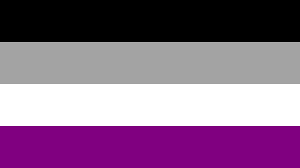A look at the Asexual Aromantic Alliance and who they are

Asexual Flag
February 10, 2019
When looking at the LGBTQIA+ community at Iowa State, some people may happen to overlook the A. That’s why the Asexual Aromantic Alliance was created three years ago, to create a space for individuals who identify on that spectrum and their allies.
“There was not enough representation on campus and it was hard to find to find a community for specifically asexual aromantic issues and talk about those issues because a lot of times that voice gets drowned out,” said Kathryn Kananen, president of the Asexual Aromantic Alliance and senior in bioinformatics and computational biology, when explaining why the alliance was created.
The Aromantic Asexual Alliance website states its mission is to provide a safe and inclusive space for members of the asexual and aromantic community along with their allies as well as to provide a safe and responsible social interaction between the asexual and aromantic community at Iowa State and help eliminate acephobia.
The alliance has over 20 members and are looking to grow their group with individuals from the asexual aromantic community and their allies. The only qualifications the alliance asks of prospective members is that “members must be supportive and open to learning and interacting with different identities,” according to the Asexual Aromantic Alliance website.
“We are a chill place for any identity, especially anyone who wants to meet someone within the ace-spectrum. We do chill activities, we do movies, crafting, just community building,” Kananen said.
Unlike some other LGBTQIA+ student organizations at Iowa State, the Asexual Aromantic Alliance focuses more on creating a community rather than activism. There are however many issues or stereotypes that the asexual and aromantic community faces today. Kananen and Amy Popillion, adviser for the Asexual Aromantic Alliance and lecturer in the human development & family studies department, talked about these issues.
“Within the LGBTQIA+ community, there is this hierarchy ladder that happens and in my opinion [the asexual aromantic community] tends to fall on the lower rung of that,” Kananen said.
Popillion looked more toward a teaching approach and how she advocates for diversity and inclusion of different individuals within her classroom.
“Just because some identifies as asexual doesn’t mean that they don’t like to cuddle or be intimate, that is something that I try to dispel because when someone hears asexual they automatically disconnect from anything romantic or intimate without realizing that it’s on a spectrum,” Popillion said.
Kananen explained that often times the asexual and aromantic community is shoved out of various communities for not being the same.
“[The asexual and aromantic communtiy] also tends to be brought up as this unicorn of an identity, so we are kicked out of the LGBT community to a point where they say “you don’t belong here, you are not technically part of this community” and the rest of the community says you don’t belong here either,” Kananen said.
Kananen also talked about how both the LGBT and straight communities may take up the voice of the asexual aromantic community but will often misrepresent the community or get the message wrong. They also talked about a personal experience where a friend took them to a dorm room filled with boys and tried to get Kananen “cured.”
“It could have been a very bad situation had they been bad individuals,” Kananen said.
According to a PDF on the Center for LGBTQIA+ Student Success website, the term asexual is defined as “a person who is not sexually attracted to anyone. In its broadest sense, asexuality is the lack of sexual attraction and the lack of interest in and desire for sex. However, some asexual people might experience emotional attraction or other non-sexual attractions.”
According to Dictionary.com the term aromantic, which many people may confuse with asexual, is different. Simply, “an aromantic person is someone who doesn’t experience romantic attraction.”
“People often get asexuality and aromanticism mixed up,” according to Dictionary.com. “While they’re similar in their lack of attraction, the domains in which lack of attraction exists are different. The distinction lies in the difference between sexual orientation and romantic orientation. A person’s romantic orientation describes a pattern or lack thereof of romantic attraction like having a crush on a specific someone. A person’s sexual orientation describes a pattern or lack thereof of sexual attraction.”
The A in LGBTQIA+ can also mean ally.
“A person from a dominant social group who openly affirms and advocates for the safety, dignity and inclusion of others from a subordinated social group,” according to a PDF provided by The Center. “In an LGBTQIA+ context, an ally is someone who confronts heterosexism, homophobia, biphobia, transphobia and heterosexual and cisgender privilege in themselves and others.”






